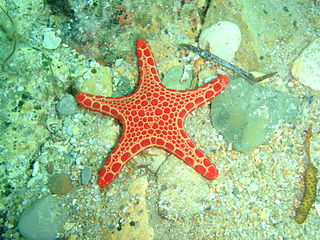
The Poeciliidae are a family of freshwater fishes of the order Cyprinodontiformes, the tooth-carps, and include well-known live-bearing aquarium fish, such as the guppy, molly, platy, and swordtail. The original distribution of the family was the Southeastern United States to north of Río de la Plata, Argentina, and Africa, including Madagascar. Due to release of aquarium specimens and the widespread use of species of the genera Poecilia and Gambusia for mosquito control, though, poeciliids can today be found in all tropical and subtropical areas of the world. In addition, Poecilia and Gambusia specimens have been identified in hot springs pools as far north as Banff, Alberta.

Acinonyx is a genus within the cat family. The only living species of the genus, the cheetah, lives in open grasslands of Africa and Asia.

Peripatus is a genus of velvet worms in the Peripatidae family. The name "peripatus" is also used to refer to the Onychophora as a whole, although this group comprises many other genera besides Peripatus. The genus Peripatus is found in Central America, the Caribbean and northern South America.

Acacia, commonly known as the wattles or acacias, is a large genus of shrubs and trees in the subfamily Mimosoideae of the pea family Fabaceae. Initially, it comprised a group of plant species native to Africa and Australasia, but it has now been limited to contain only the Australasian species. The genus name is New Latin, borrowed from the Greek ἀκακία, a term used by Dioscorides for a preparation extracted from the leaves and fruit pods of Vachellia nilotica, the original type of the genus. In his Pinax (1623), Gaspard Bauhin mentioned the Greek ἀκακία from Dioscorides as the origin of the Latin name.

Phalangiotarbi is an extinct arachnid order first recorded from the Early Devonian of Germany and most widespread in the Upper Carboniferous coal measures of Europe and North America. The last species are known from the early Permian Rotliegend of Germany.
Nephelomys keaysi, also known as Keays's oryzomys or Keays's rice rat, is a species of rodent in the genus Nephelomys of family Cricetidae. It is found from southeastern Peru to northern Bolivia on the eastern slope of the Andes in Yungas humid forest at altitudes of 1000 to 2600 m. Although its continued existence is not in serious danger and it is listed as "least concern", destruction of its habitat may pose a threat to some populations.

Dichomeris is a genus of moths in the family Gelechiidae erected by Jacob Hübner in 1818.

Goniasteridae constitute the largest family of sea stars, included in the order Valvatida. They are mostly deep-dwelling species, but the family also include several colorful shallow tropical species.
Ogmodirus is an extinct genus of plesiosaur found in the Cenomanian-Turonian Greenhorn Limestone of Kansas. It may be member of the Elasmosauridae, a group of marine animals related to Elasmosaurus, but the condition of the fossils discovered to date means the genus is dubious beyond Plesiosauria. The type species, O. martini, was named by Samuel Wendell Williston and Roy L. Moodie in 1913. The original specimen consisted of a pelvic girdle, limb elements, and more than fifty cervical (neck) vertebrae discovered in Cloud County, Kansas. A second species, Ogmodirus ischiadicus, has since been referred to Styxosaurus. Sepkoski (2002) assigned Ogmodirus to the Plesiosauria.
Conjunctio is an extinct genus of dissorophid temnospondyl amphibian from the early Permian of New Mexico. The type species, Conjunctio multidens, was named by paleontologist Robert L. Carroll in 1964.

The Apusomonadida are a group of protozoan zooflagellates that glide on surfaces, and mostly consume prokaryotes. They are of particular evolutionary interest because they appear to be the sister group to the Opisthokonts, the clade as that includes both animals and fungi. Together with the Breviatea, these form the Obazoa clade.

Nephelomys pirrensis, also known as the Mount Pirre rice rat, is a species of rodent in the genus Nephelomys of family Cricetidae. Its type locality is at Mount Pirri or Pirre in eastern Panama, at an altitude of 4,500 feet (1,400 m), and it has also been recorded on Mount Tacarcuna.
Sintocephalus is an extinct genus of dicynodont therapsid from the Late Permian of South Africa. Fossils are known from the Cistecephalus Assemblage Zone of the Beaufort Group. The type species of Sintocephalus, S. alticeps, was first named in 1913 as a species of Dicynodon. The genus was erected in 1934, but in subsequent years its species were often regarded as members of other dicynodont genera.

Lepidoperca is a small genus of fish belonging to the Anthiinae subfamily. It includes ten species.
The Schaudinnellidae are a family of parasitic alveolates in the phylum Apicomplexa.
Machadoella is a genus of parasitic alveolates in the phylum Apicomplexa.
Myriospora is a genus of parasitic alveolates belonging to the phylum Apicomplexa.

Lestoidea is a genus of damselflies in the family Lestoideidae, commonly known as bluestreaks. Its species are endemic to north-east Queensland, Australia, where they inhabit rainforest streams.

Poeciliinae is a subfamily of killifish from the family Poeciliidae which contains species from the Americas which are collectively known as the livebearers because many, but not all, of the species within the subfamily are ovoviviparous.
Homalocnemis is a genus of flies which is placed in a family of its own, the Homalocnemiidae. There are about seven species in the genus found in the Afrotropical, Neotropical, and Australasian regions, suggestive of a Gondwanan origin. The genus was formerly considered a primitive empidoid and placed variously in the Hybotidae or in the empidid subfamily Brachystomatinae. They are recognized by their wing venation which includes a long anal cell and a long basal segment of the antennal style.











